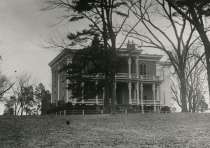
Once a self-supporting plantation of 1500 acres and 60 slaves, Clover Bottom was the site of several encampments and now houses the State Historical Society. John McCline’s memoir gives a picture of slave life there.
The Clover Bottom plantation was the sprawling antebellum home of Dr. James Hoggatt, his wife, Mary Ann Saunders, and their two nieces. Built in the Italianate style in 1858, the mansion had 23 rooms, 14-foot ceilings, and high doors with elaborate transoms. Each feature reflected the wealth of its owners. In fact, Clover Bottom was just one of three plantations owned or co-owned by Dr. Hoggatt in both Rutherford County and the state of Mississippi. While Dr. Hoggatt was the patriarch of the estate, he seemed to take a backseat in day-to-day operations, leaving much of that work for his wife and his overseer. By the start of the Civil War, Clover Bottom had grown to 1,500 acres operated by 60 slaves, rendering the plantation completely self-sufficient. In the early months of war, spotting Confederate troops on the pike on their way to Nashville was almost a daily occurrence. After Nashville fell, Federal troops could be seen marching down that same road. Quite often, soldiers encamped on the grounds of Clover Bottom. In July 1862, then Col. Nathan Bedford Forrest [CSA] arranged for his cavalry to camp on the Hoggatt’s property—just a few miles outside of Federally occupied Nashville. The Hoggatts put on a literal barbecue for their guests, handing out ham slices, corn bread, and hoe cakes. Much of Clover Bottom’s prewar and early war history can be found in John McCline’s Slavery in the Clover Bottoms. McCline was born into slavery on the plantation, remaining there until the age of ten or eleven when he attached himself to a passing Federal regiment. From 1862 to 1865, McCline served the Federal army as an assistant teamster, caring for the mules and horses. Today the Clover Bottoms plantation is reduced to nine acres with the main house, family cemetery, and a few outbuildings from later periods of agricultural use. Clover Bottom mansion is now the home of the Tennessee Historical Commission. The first floor is open for public visitation, but visits can be made after arranging an appointment in advance by calling the Commission.
Tools
Key Facts
- Clover Bottom was one of three Hoggatt family plantations
- A memoir written by former slave John McCline tells much of the history, including several troop encampments
- McCline attached himself to a Union regiment and left at age 10 or 11




